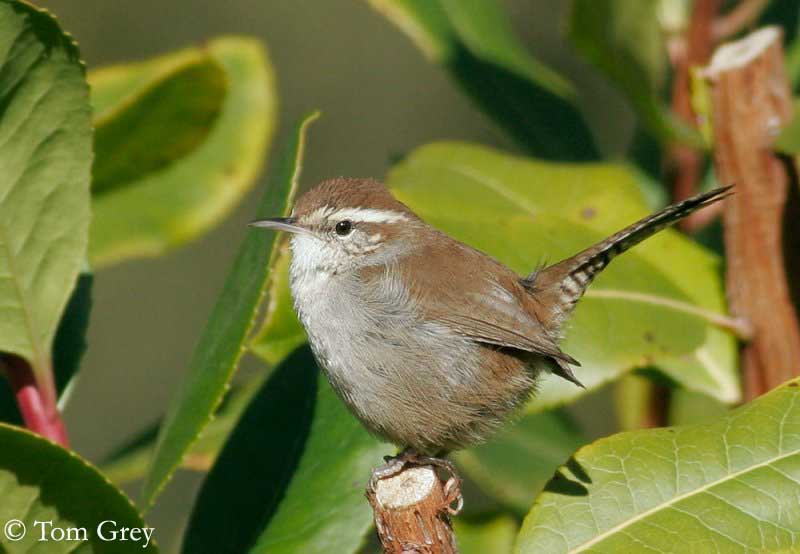
Bewick’s Wren
Thryomanes bewickii
Passeriforme Order – Troglodytidae Family
BIOMETRICS:
Length: 13 cm; Wingspan: 18 cm; Weight : 8-12 g
LONGEVITY: up to 8 years
DESCRIPTION:
Bewick’s Wren has rusty-brown upperparts and greyish-white underparts. It has less spotted plumage than other wrens’ species. Its long tail is brown, finely barred with blackish and white tips on outer feathers.
Forehead, crown and nape are brown, as back. We can see a conspicuous white eye-line, from the base of the bill, crossing above the eye and joining the nape. Cheeks are white, finely spotted with brown. Chin and throat are white.
Slender bill is slightly down curved and pointed. It is dark, with pale blue base on lower mandible. Eyes are dark brown. Legs and feet are pale brown.
Both sexes are similar.
Juvenile resembles adults, but it has scaled appearance on breast, due to dark edges of feathers.

The most similar species is the Carolina Wren, slightly larger, with buffy underparts, and it lacks white on outer tail feathers.
We find several subspecies:
Eastern “T.b. bewickii” has bright reddish-brown upperparts.
South Texas “criptus” is duller, but slightly tinged red.
Western interior “eremophilus” is greyer than others, and widespread.
Northwest “calaphonus” is dark, richly coloured, with rufus tint.
Western coastal races become browner and darker as they travel northwards.
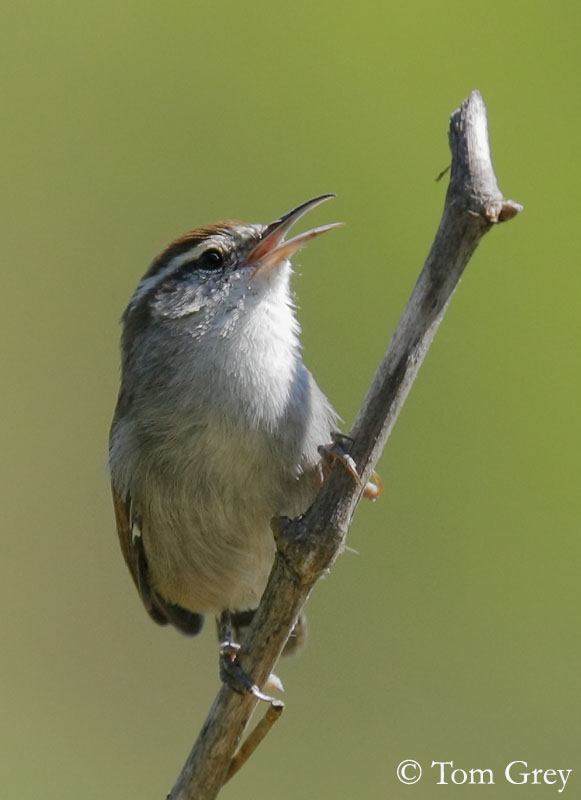
VOICE: SOUNDS BY XENO-CANTO
Bewick’s Wren’s song varies according to the range. Song is a high, thin buzz and warble, often compared to Song Sparrow’s song. We can hear series of whistled phrases, and also trills.
Calls include a flat, hollow “jip”, and a raspy scolding alarm call.
Song includes three parts: first, a high quick opening of two or more notes; then, some lower notes of less quality, and at the end, a very delicate fine trill. (Hoffmann)
The song repertoire of each wren is developed before the first winter, and is retained for life. It learns songs from neighbouring territorial males, instead its father.
HABITAT:
Bewick’s Wren lives in shrubby areas, near thickets or woodlands, scrubs in open country and chaparral. It often frequents vicinity of human habitations, and we can find it in residential areas in towns and cities. But it is often found near streams.
RANGE:
Bewick’s Wren range extends from southern British Columbia to southern Mexico. The species breeds along Pacific coasts, and also from southern Wyoming to central Missouri and southwards to Arizona, eastern Texas and into southern Mexico.
Bewick’s Wren is resident in western parts of its range. Some birds from northern parts move southwards in winter. Eastern birds are largely migratory.
BEHAVIOUR:
Bewick’s Wren forages in branches and foliage, shrubs, and on the ground to glean insects. It also searches for food in lower branches and tree trunks. It probes into bark crevices with its thin pointed bill, picking insects off the bark. When it feeds on the ground, it flips aside the litter with its bill, but it doesn’t scratch with its feet. This bird is always on the move while foraging, progressing by short hops from branch to branch. It also clings to the bark, and creeps up a tree trunk by brief hops. It may sometimes hang upside down on the underside of branches and foliage.
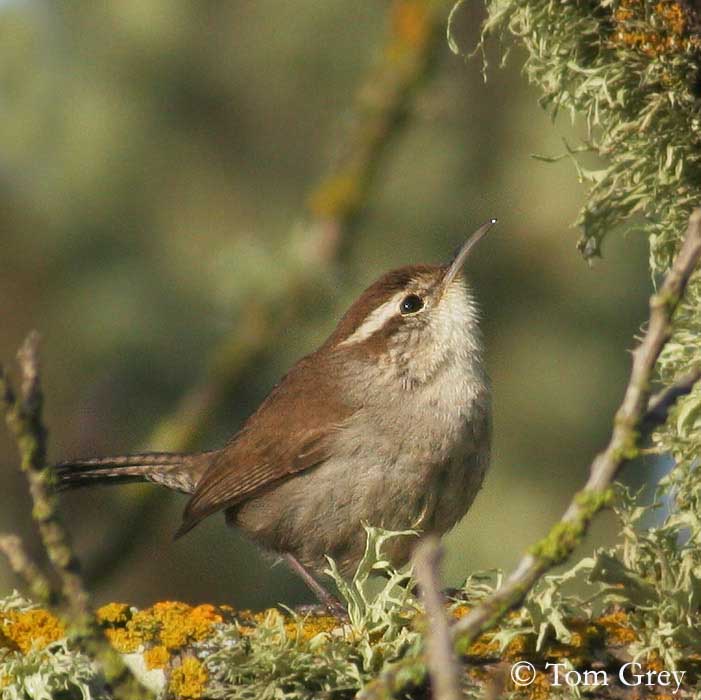
Outside of the breeding season, Bewick’s Wren may join mixed foraging flocks. They have territorial conflicts with Song Sparrows and House Wrens. Bewick’s Wren defends its territory all year round.
It moves with its tail generally erect. It is a very active bird, always running or flying from branch to branch, hopping briefly and sometimes sidewise, descending to the ground or in lower vegetation, and returning in higher branches with rapid movements.
Breeding season usually begins in April. If birds are resident, pairs are formed and territories established in late winter. When they are migratory birds, pairs may be formed when they arrive on breeding areas.
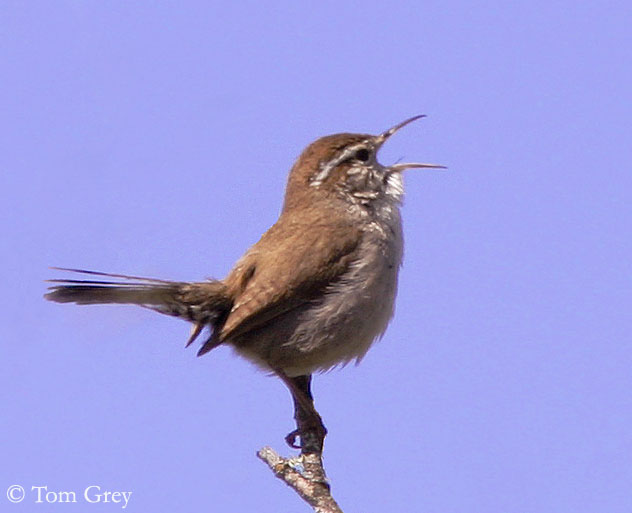
Male sings a lot, often perched on exposed places, to attract females and maintain its territory. Male and female forage in different places, male higher in bushes than female. Both use several calls notes. Male sings to keep female and territory, and female when she is ready for copulation. After breeding season, males stop their songs and defence of territories. Male and female establish separated territories during winter.
When alarmed or threatened, Bewick’s Wren hides into the bushes or undergrowth.
Occasionally it may attack nests of other Bewick’s Wrens, but it is itself often attacked by House Wrens which destroy eggs.
FLIGHT:
Bewick’s Wren performs a weak fluttering flight with shallow wing beats. Flights are usually on short distances and relatively low to the ground.
REPRODUCTION:
Bewick’s Wren breeds from mid-April to mid-May. Its nest may be located in various places such as natural or artificial cavities, woodpecker holes, crevices in buildings or rock walls, and even nest-boxes. But Bewick’s Wren may adopt various other stunning places such as tin can, coat pockets or sleeves, baskets…
Materials used for the nest depend on locality. Birds use whatever they find in the surrounding. They prefer to nest near or on the ground, among tree roots in wooded areas.
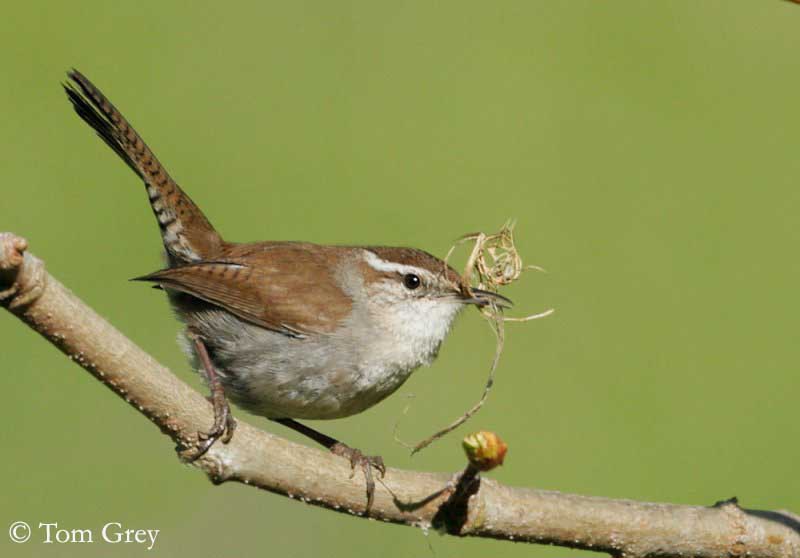
Both adults build the nest, a cup open at the top. It is made with sticks, leaves, grasses, rootlets and other debris. Interior is lined with feathers and hair, and often with bits of snakeskin.
Female lays 5 to 7 white eggs with brown, lilac or purplish dots. Incubation lasts about 14 to 16 days, by female. She is fed at nest by the male during this period. Altricial chicks are fed by both parents with small insects, worms and caterpillars. Young fledge at 14 to 16 days after hatching. Parents care them and they remain together two weeks more after leaving the nest. Sometimes, female continues feeding her first brood while she is laying the second.
This species may produce one or two broods per season, sometimes three in the extreme southern range.
DIET:
Bewick’s Wren feeds mainly on invertebrates such as bugs, beetles, bees and wasps, caterpillars, butterflies and moths, and on spiders. They also consume some vegetable matter during winter.
PROTECTION / THREATS / STATUS:
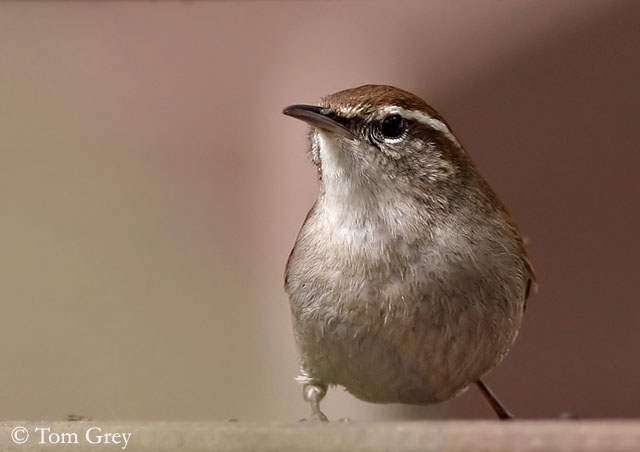
Bewick’s Wren is preyed upon by snakes and birds of prey.
Bewick’s Wren populations are in decline. Hard competition with House Wrens which destroy eggs and nests of other birds plays an important role in this decline. Starlings and House Sparrows, introduced species, and Carolina Wrens and Song Sparrows use similar nest sites too.
Bewick’s Wren decline is not very well explained. Habitat loss is usually the main cause of population declines, but in this case, changes in the habitat benefit to this species, adding more nest- sites. Some epizooty was mentioned, without firm belief. It really seems that the main reason is the hard and continuous competition for nesting sites with other species named above.
Bewick’s Wrens populations are now at low level and may still decline. This species is listed as endangered and threatened in numerous states.
Bewick’s Wren was named by Audubon, after Thomas Bewick (1753 – 1828), an English naturalist and wood engraver.
Fr: Troglodyte de Bewick
All : Buschzaunkönig
Esp : Ratona Tepetatero
Ital : Scricciolo di Bewick
Nd : Bewick-winterkoning
Sd : Snårgärdsmyg
Photographs by Tom Grey
His website :
Tom Grey's Bird Pictures
Text by Nicole Bouglouan
Sources:
HANDBOOK OF THE BIRDS OF THE WORLD Vol 10 by Josep del Hoyo-Andrew Elliott-David Christie - Lynx Edicions - ISBN: 8487334725
WRENS, DIPPERS AND THRASHERS by Brewer David – illustrated by Barry Kent Mackay- Yale University Press - ISBN: 0300090595
Avibase (Lepage Denis)
All About Birds (Cornell Lab of Ornithology)
What Bird-The ultimate Bird Guide (Mitchell Waite)
Wikipedia (Wikipedia, The Free Encyclopedia)
Bird Web (Seattle Audubon Society)